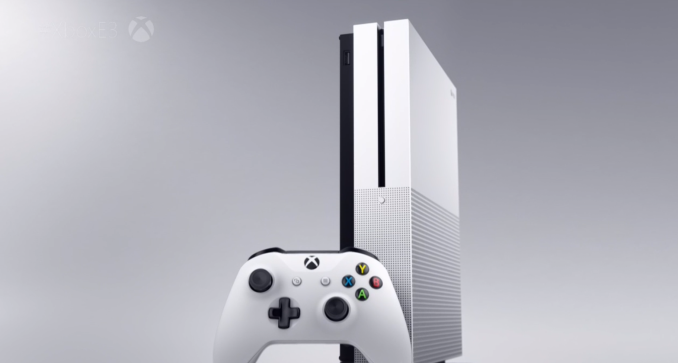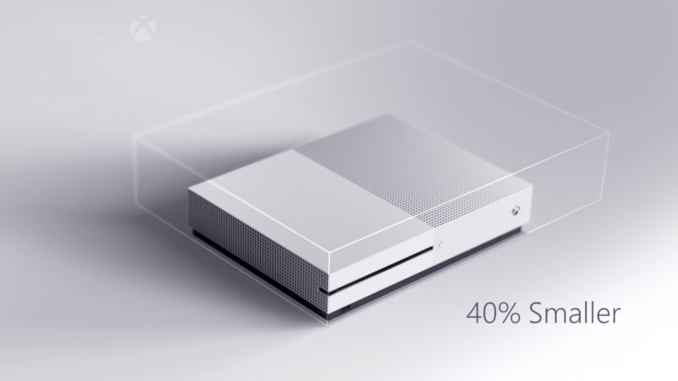Microsoft Announces Xbox One S Console: A Slimmer Design
by Ian Cutress on June 13, 2016 12:30 PM EST
Today at the annual Electronic Entertainment Expo (E3), Microsoft has lifted the lid on their new Xbox One console design. The Xbox One is part of the eighth generation of consoles, and was originally released in November 2013. The new Xbox One S is assumed to have similar hardware inside, however the design is taking up 40% less volume. Typically when a device changes in volume this much, as with previous generations that have launched slimmer designs, inside there will be a processor on a smaller process node and optimized for power for the same performance. This allows a smaller more efficient design, and in this case Microsoft has integrated the power supply into the console, negating the need for a large power brick.
Other highlights for the launch include HDR and 4K output support, although it is unspecified if this is through HDMI 2.0 or DisplayPort. The main thing here is for streaming video from services such as Netflix, Amazon and Hulu rather than running games at 4K. Theoretically it also means that the video outputs can offer enough bandwidth for some of the virtual reality headsets on the market/coming to market. The new Xbox One S will support HDR as well, suggesting that it must also support HDMI 2.0a or DisplayPort 1.4. HDMI 2.0a is more likely, as DisplayPort which isn't part of the original Xbox design and would suggest that the SoC has been adjusted to support it. Though for consistency we would assume that the core GPU architecture is the same, and is more likely to be HDMI 2.0a. As mentioned by nathanddrews in the comments, HDMI 2.0a can't support 10-bit 4:4:4 chroma like DisplayPort 1.4, which is what we would expect on a PC-like interface, but it it does do 10-bit in 4:2:0 chroma, which is what we would expect for games and film.
The controller for the Xbox One is also new, featuring a redesigned textured grip on the rear and what looks like at an attempt to improve the ergonomics. The Xbox One Elite Controller was released a while back at $150, but the new controller is designed to mimic the one originally released with the Xbox One. The new controller will be available for worldwide purchase for $60, and now supports Bluetooth for connection to PCs so that USB dongles are not needed. The controllers should still use WiFi Microsoft's proprietary wireless communication technology to Xbox One as standard, as these controllers need to work with the original Xbox One consoles.
The Xbox One S can support up to 2 TB of a hard disk drive, suggesting that in the console space having more capacity (for games as well as downloaded shows) is more important than solid state storage. There will be 500GB and 1TB editions as the main set, with 2TB being a special launch edition.
At $299, the One S comes in at the same price as the original Xbox One 500GB console with a one-game bundle when we compare prices on Amazon. In fact, checking the press release shows that $299 is the 500GB edition of the One S, a 1TB model at $349, and the 2TB Special Edition will be available in certain markets at $399 starting from early August. Additionally, the official Xbox One Vertical Stand will be on sale for $20.
When it was first launched, the expected lifetime of a the console generation was around five to seven years, which means that we currently sit in the middle of that timeframe, and if a manufacturer was going to offer an updated model, this would be it. Updating a console design mid-generation is nothing new, we’ve seen it as far back as the original Playstation, however this generation has an additional issue: with everyone talking about VR, no-one is confident that the current generation of consoles is up to the task. So it will be interesting to see how the new Xbox One S will play in this space, now that the video output is up to the task.
Source: Microsoft at E3






















58 Comments
View All Comments
inighthawki - Monday, June 13, 2016 - link
The lack of bugs in older technology comes from the simplicity. The design of a Pentium processor is multiple orders of magnitude simpler than a skylake i7. Serial and Parallel ports are basically electrical wires compared to USB-C. Old transport protocols didn't even have concepts of things like encryption, compression, etc. There were also a lot of bugs in older technologies as well, people often just worked around them in software.The introduction of new technologies to replace the old ones is not done for a purpose. Much like software, new features are added, and people want those features. New RAM technologies require hardware changes to support lower power draw, faster latency. New CPU sockets are requires to interface between all the new features on the motherboard. Do you not want faster computers? Or are you satisfied with hard drives that still run at IDE speeds, good ol' serial ports running at a blasting 1KB/s, and let's not throw away those good 26K modems...
I've seen some people resistant to change, but you must take the cake.
Also nothing prevents you from owning a phone longer than two years. I still own a windows 7 phone from 2011 which still works great, which I only recently replaced cause I got a new phone for free. Otherwise I'd still be using it.
djsvetljo - Monday, June 13, 2016 - link
That is exactly my point - you just said it better. When technology scales up, they shouldn't scale up the bugs. That is what's wrong. Thanks for that thought.Regarding the sockets - I get it, you were told that's the way it needs to be. Have you ever thought that a socket can be made extra provisioned, future proof - of course it can be. But that's where the "milking" part of my first comments comes in. They have to milk is every 2-3 years.
And regarding the phone example, if MS pulls the plug on WP7 your phone will be paper weight. Probably a dozens services will stop working, no longer access to store and so on.
inighthawki - Monday, June 13, 2016 - link
>> That is exactly my point - you just said it better. When technology scales up, they shouldn't scale up the bugs. That is what's wrong. Thanks for that thought.You make it sound like they purposely add bugs. I also think you forget that many first gen older technologies had issues too.
"Regarding sockets" - I think you have an extremely oversimplified view of hardware design. This isn't a piece of software where we'll just add a few reserved fields at the end of the struct in case we need to reuse them. The physical structure of the chip changes all the time, and the pin placement is that way for many reasons - one of which is physical distance to the components which it touches. You can't just "add a few pins in case we need them later" for new features.
As for phones - services and apps last longer than 2 years. The 2 year cycle is commonly only due to outdated hardware, not software. I know people who still have flip phones and some who have 5-6 year old iphones and android devices that still work great. How old exactly do you want to keep your technology, like 10 years at a time?
michael2k - Monday, June 13, 2016 - link
You must own an iPhone if you're worried about not buying a new phone every two years. My original iPhone 4S has been handed down to my daughter, and is still getting software updates; from 2011 to 2016. My iPhone 5S was handed down to my son. Even though iOS 10 isn't being pushed to the iPhone 4S, the 4S is still fully functional with iOS 9 5 years later.inighthawki - Monday, June 13, 2016 - link
I can't tell if you're being really sarcastic or are really that stupid.RiZad - Monday, June 13, 2016 - link
I think its the latterdjsvetljo - Monday, June 13, 2016 - link
Smells like teen spirit.djsvetljo - Monday, June 13, 2016 - link
Not being sercastic. But I can tell you are under 2. May be 22.djsvetljo - Monday, June 13, 2016 - link
25*BlueScreenJunky - Monday, June 13, 2016 - link
You're looking at it wrong I think :It's not a new console, it won't allow you to play new games and it won't make the old games any better, so it's still the Xbox One and if you already own one you probably have no reason to change it.
On the other hand, since the Xbox one was released a lot of things have changed. The GPUs and CPUs have gotten smaller, more power efficient, and cheaper to produce, there is now some UHD content (4K resolution and High Dynamic Range colors), and the hdmi2.0 standard was created. So microsoft could either keep building the exact same console, or make use of these new technologies to make a smaller and less power hungry console, as well as adding UHD capabilities, so people who don't have an Xbox one yet will have a slightly better product if they buy it now.
I think It makes sense.
Of course some people will also "upgrade" their Xbox One to an Xbox One slim, but I really don't think that's the point, it's really more of a "refresh" of the existing product aimed at those who are still on the verge of buying one...